What is suevite?
The term 'suevite' denominates a particular type of rock generated during larger meteorite impacts on Earth, i.e., suevite is an impactite1. Suevite, as a specific rock type, was first mentioned and described by the German geologist Dr Eberhard Fraas in 1919 [1] at the Nördlinger Ries crater that covers parts of Bavaria and Baden-Württemberg in southern Germany. The name 'suevite' - meaning 'the rock of the Swabians2' - reflects its type locality3 in Swabia. On his page 15, Fraas states:
(Translated from old-fashioned German:) "The main mass of the Ries tuffs is composed of large volcanic projectiles, up to head-sized excavation slags, flat cake- to ropy-shaped contorted bombs, as well as smaller and finest lapilli and dust size grains, small and large clasts of fried, distinctly molten [...] granites, gneisses, and other crystalline rocks, whereas the sedimentary material incorporated only shows traces of heat but no evidence of melting. [...] On fresh surface, excavation slags unravel a glassy nature, commonly fine, 'schlieren'-rich and bright to dark (eutaxitic) striation, and they are solid and partially vesicular and foamy. [...] They thereby constitute a unique case of regional melting, in the particular way that the affected rocks and melt flow material intimately interpenetrate. [...] Therefore, this mixed rock of the volcanic Ries represents a rock type that - considering its area of occurrence in the Swabian Ries - I would like to call 'suevite'.
As you see, the Ries crater was still considered a volcanic feature about 100 years ago - and until 1961. Click here for the full original Fraas article.
According to early and more recent scientific definitions in the impact-related literature [2;3], suevite represents a "polymict impact breccia with a clastic matrix/groundmass containing fragments of impact glass and shocked mineral and lithic clasts" - or simply: suevite is a rock made up of mixed-type fine and coarser fragments of crushed rocks and minerals that show microscopic evidence of instantaneous impact pressure deformation and heating effects summarised under the term 'shock metamorphism'4 [4]. Moreover and importantly, suevite also contains variable amounts of partially to completely molten rock and mineral material initially transformed into glasses; the latter are commonly found as so-called 'flaedle', derived from the original Swabian word used to describe fluidally textured, locally contorted, and partially elongated glassy melt particles.
Suevite commonly shows a greyish particulate groundmass containing darker melt particles, like at the Ries crater (Germany), the Bosumtwi crater (Ghana), the Wanapitei crater (Canada), or the Logoisk crater (Belarus). However, depending on the properties of the 'target' rocks affected in the impacted region, suevite may exhibit highly variable compositions and colors, such as green (Rochechouart, France), black (Gardnos, Norway), brown (Puchezh-Katunki, Russia), or partially lilac (Dellen, Sweden). Unlike suevite at the Ries crater, the target of which is composed of multiple layers of sedimentary rocks on top of the crystalline basement, this rock can also be generated from purely sedimentary lithologies, such as sandstones (Goat Paddock, Western Australia) [8], limestones (Steinheim, Germany) [9], or crystalline rocks only (Mistastin, Canada) [10]. Suevite-like impact breccias have also been recovered from the Moon where they are part of the Lunar regolith. Alteration and decomposition of the originally fresh melt (glass) particles and groundmass can cause a change in the optical appearance of the rock. The recognition of suevite in the field, in accord with the detection of shock metamorphic features in these rocks, plays an important role in impact research and the confirmation of newly recognised meteorite impact structures on Earth.
Although the term suevite was originally issued to describe this type of rock at the Ries crater, suevite occurs at a number of well-preserved meteorite impact structures worldwide. Despite decades of impact research and a vaste literature that deals with the specific 'shock petrography' and geochemistry of suevites and other impactites, the formation and mode of emplacement of suevite is still somewhat debated; earlier studies proposed that suevite is deposited as a 'fall-back' layer of shocked and molten rock material as the hot impact 'vapor cloud' (also 'vapor plume') collapses soon after impact and as its constituents rain down to Earth to cover the fresh impact crater and its close surroundings, thereby forming parts of the final impact 'ejecta blanket' (e.g., [5]). However, field relations of impactites at various terrestrial impact structures (e.g., at the Ries, Germany; Rochechouart, France; or Mistastin and Manicouagan, both Canada) and recent revisiting studies (e.g., [6;7]) rather suggest that suevite is presumably generated during dynamic, 'ground-hugging', crater-outward flow movement of impact ejecta rather than by pure fallback. This mode of suevite emplacement also includes partial injection into the underlying rocks. In general, suevite emplacement might be somewhat similar in its deposition dynamics to that of volcanic pyroclastic flows, such as those that produce ignimbrites. This is underlined by a similar arrangement of melt particles (flaedle in suevite vs. pumice in the volcanics) and a similar degassing behaviour. Accretionary (multilayered) lapilli commonly encountered in terrestrial suevites may suggest that surficial and/or subsurficial water might also play a key role in suevite formation and deposition. New models proposed for the generation of suevite at the Ries crater in Germany suggested a two-step sequence forming minor basal masses of "primary suevite" from a "primary ejecta plume"; the majority of the overlying suevite is considered a "secondary suevite" generated from an explosive fuel-coolant interaction between water and volatile-rich sedimentary rocks and the pool of hot impact melt inside the fresh impact crater, causing a "secondary plume" [11;12].
Based on the radioactive decay of potassium to argon and applying the 40Ar/39Ar dating method (also applied to the Ries suevites [13]), fresh suevite melt particles can be used to determine the age of an impact event that produced these melts and may also provide geochemical clues towards the nature of the cosmic projectile (such as stony or iron meteorites) that hit our planet in the past. This is particularly interesting when it comes to the potential and long-time debated linkage between large impact events and catastrophic biologic crises throughout Earth's geologic history - as in the case of the large Chicxulub impact, Mexico, at the Cretaceous-Paleogene boudary 66 million years ago, which is thought to have wiped out the dinosaurs and many other species [14]. Last but not least, suevites may contain hydrothermal alteration products and thereby monitor potential economic resources encountered and explored at terrestrial impact structures [15]. In this context, suevite was used as a major building stone at the Rochechouart impact structure in France, where it builds up the ancient Gallo-Roman thermae at Chassenon. Likewise, suevite is also a major building stone in and around the Ries crater, Germany, where many medieval buildings, such as St. George's church and parts of the town hall in Nördlingen or Katzenstein castle near Dischingen, are made from this particular rock.
Footnotes
1Impactites are rocks affected by impact-induced shock metamorphism and contain traces thereof. Apart from suevite, typical impactites comprise shocked and shattered target rocks grading into monomictic (monomodal) and polymictic (mixed-rock) lithic impact breccias, as well as impact melt rocks that exhibit a formerly molten crystalline or glassy rock groundmass. A systematic summary of impactites is given by [3] and [4].
2Swabians are a tribe that lives in Swabia (Latin: Suevia; German: Schwaben), a region roughly between the cities of Stuttgart, Augsburg, and the Lake of Constance in Southern Germany.
3Type locality means the location where a specific type of rock was originally found and studied in its very typical mode of occurrence. Rocks or minerals are commonly named after their type locality, such as the mineral cristobalite (type locality: Cerro San Crist�bal, Mexico) or the rock monzonite (Monte Monzoni, Italy). The Latin word for Swabia, Suevia (see above), accordingly defines the rock name for suevite.
4Shock metamorphism is very different from 'usual' regional metamorphism (i.e., metamorphism induced by orogenic processes) in the sense that extremely high shock pressures and post-shock temperatures act 'instantaneously' and leave their individual traces in the rocks and minerals affected. Whereas pressures in endogenic processes rarely exceed about 3 Gigapascals (GPa) (i.e., blue-shist and eclogite facies regional metamorphism) and about 1000�C (granulite facies regional metamorphism) within hundreds of thousands and even millions of years, much higher pressures and temperatures apply during shock metamorhism within fractions of a second. Macroscopic shock metamorphic features in the field include shatter cones (a specific penetrative fracture pattern typical of impact); microscopic shock metamorphic features include, amongst others, shocked quartz characterised by the presence of either bubble-'decorated' or non-decorated planar deformation features ('PDFs'; straight planar lamellae following crystallographic planes that are generated at shock pressures of about 8-35 GPa), high-pressure mineral polymorphs (such as 'impact diamonds' from graphite; coesite and stishovite from quartz/silica), diaplectic glasses (diaplectic silica glass; maskelyinte' from plagioclase feldspar that form by pressure-induced solid-state amorphisation without melting at about 35 GPa onward), 'ballen silica' (a high-temperature form of silica generated via cristobalite crystallisation at temperaturtes exceeding about 1200�C), as well as normal (melt) glasses (such as lechatelierite from quartz/silica, which forms at shock pressures >50 GPa and corresponding post-shock temperatures >1500�C). Shock metamorphism has also been described for minerals other than quartz and feldspar, such as for calcite, gypsum/anhydrite, sillimanite, zircon, and other rock-forming minerals. A general review of shock metamorphism is provided by [4].
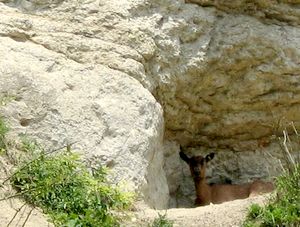
Suevite at the Altebürg quarry (type locality),
Nördlinger Ries, Germany; goat for scale
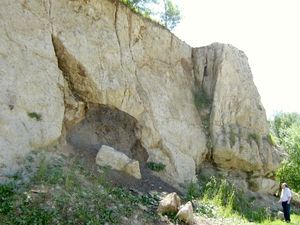
Suevite outcrop at the Aumühle quarry,
Ries crater, Germany
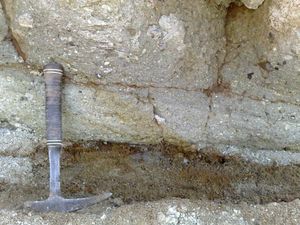
Close-up of contact between suevite
(top, grey) and underlying lithic 'bunte breccia'
(reddish-brown), Aumühle quarry
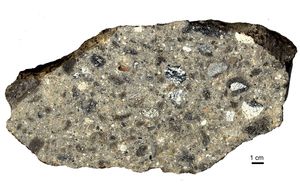
Slab of typical suevite, Ries crater, Germany
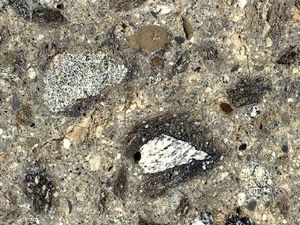
Close-up of crystalline rock fragments
surrounded by dark impact glass, all set in a
particulate matrix; compare image above
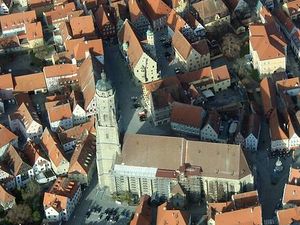
Suevite as a building stone, church St. Georg
and town hall (top, middle), Nördlingen
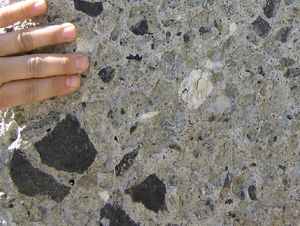
Suevite as a building stone, St. George's church,
Nördlingen; close-up
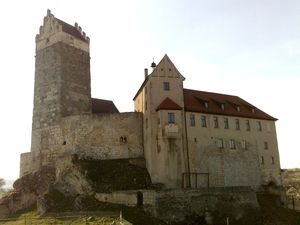
Katzenstein Castle near Dischingen is mainly
built from suevite
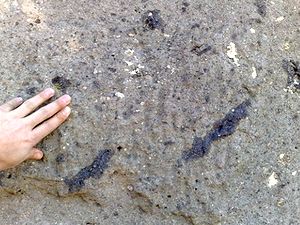
Suevite with elongated flaedle in Katzenstein
Castle building stone
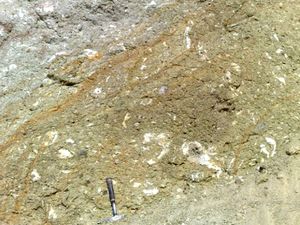
Intensely altered suevite at the Lehberg
quarry, Unterwilflingen, Ries crater; flaedle
have been almost completely transformed
into white aggregates of clay minerals
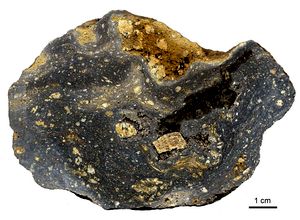
Large melt flaedle from suevite, Mien, Sweden,
containing abundant rock and mineral clasts
Sample courtesy: Peter Bockstaller,
Schopfheim, Germany
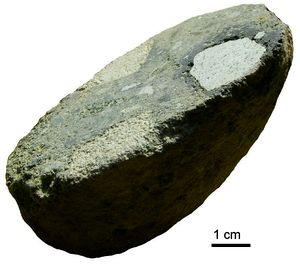
Glacially transported and rounded suevite
pebble, Wanapitei, Ontario, Canada;
note granite clast mantled by impact glass
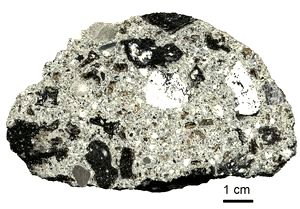
Suevite from drill core, Logoisk, Belarus,
showing white granitic rock clasts and dark melt
particles in a greyish groundmass
Sample courtesy: Dr Liudmila Glazovskaya,
Moscow State University, Russia
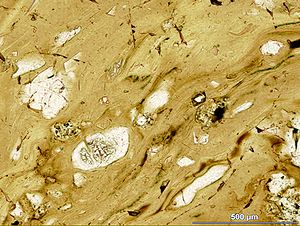
Thin section photomicrograph of schlieren
and blasen in fluidal suevite glass, Logoisk;
plane-polarised light
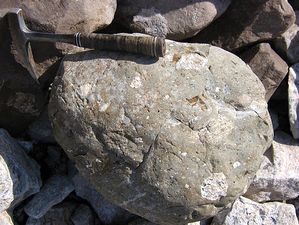
Suevite boulder, Manicouagan, Qu�bec, Canada
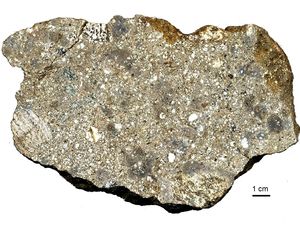
Suevite slice, Manicouagan, Qu�bec, Canada;
note darker melt particles
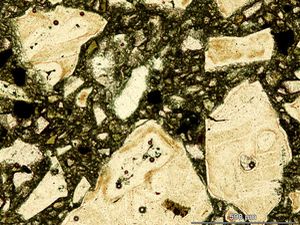
Thin section photomicrograph of recrystallised
glass particles in suevite, Manicouagan;
plane-polarised light
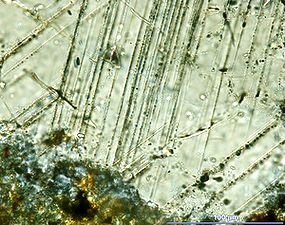
Shocked quartz with two sets of PDFs in suevite,
Manicouagan, Qu�bec, Canada;
cross-polarised light

Suevite, Lappajärvi, Finland

Suevite, Dellen, Sweden
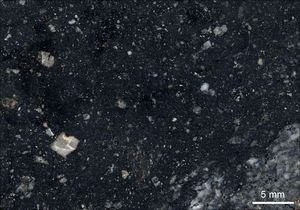
Black suevite, Gardnos, Norway
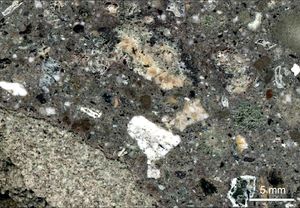
Suevite, Manson, USA
Sample courtesy: Dr Ray Anderson,
Iowa Geological Survey, USA
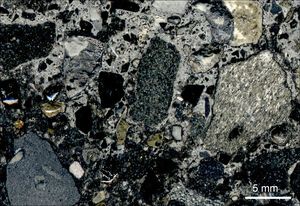
Suevite, Kara, Russia
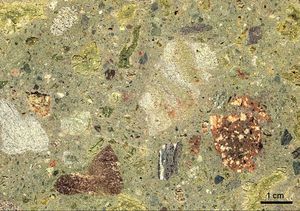
Greenish suevite, Rochechouart, France
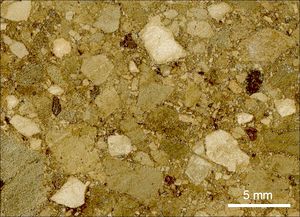
Carbonate-derived suevite, Steinheim,
Germany, with tiny darker melt particles
Sample courtesy: Landesamt für Geologie,
Bergbau und Rohstoffe, Baden-Württemberg
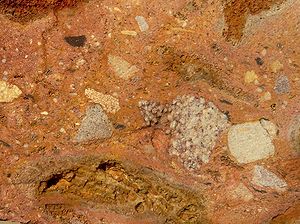
Sandstone-derived suevite, Goat Paddock,
Western Australia; melt particles are almost
pure silica; specimen width ~7 cm
Sample courtesy: Dr Dermot Henry,
Museum of Victoria, Melbourne, Australia
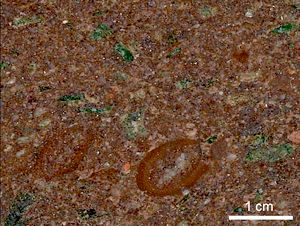
Reworked breccia, Stac Fada Member, Scotland,
containing suevite melt particles, shocked
quartz grains, and round accretionary lapilli
Sample courtesy: Dr Ken Amor,
University of Oxford, UK
All photographs shown above were taken by the author of this webpage.
Literature:
[1] Fraas E. 1919. Begleitworte zu der geognostischen Spezialkarte von W�rttemberg - Atlasblatt Bopfingen. Statistisches Landesamt, Kohlhammer, Stuttgart, Germany, 31 p. (in German).
[2] St�ffler D., Ewald U., Ostertag R., and Reimold W. U. 1977. Research drilling N�rdlingen 1973 (Ries): Composition and texture of polymict impact breccias. Geologica Bavarica 75, p. 163�189.
[3] St�ffler D. and Grieve R. A. F. 2007. Impactites. A proposal on behalf of the IUGS Subcommission on the Systematics of Metamorphic Rocks. In: Towards a unified nomenclature of metamorphic petrology, Chapter 11. Blackwell Publishers, London, UK, 30 p.
[4] French B. M. 1998. Traces of Catastrophe. LPI Contribution 954, Houston, Texas, USA, 120 p.
[5] von Engelhardt W. 1997. Suevite breccia of the Ries impact crater, Germany: Petrography, chemistry and shock metamorphism of crystalline rock clasts. Meteoritics and Planetary Science 32, issue 4, p. 545-554.
[6] Osinski G. R., Tornabene L. L. and Grieve R. A. F. 2011. Impact ejecta emplacement on terrestrial planets. Earth and Planetary Science Letters 310, issues 3-4, p. 167-181.
[7] Meyer C., J�brak M., St�ffler D. and Riller U. 2011. Lateral transport of suevite inferred from 3D shape-fabric analysis: Evidence from the Ries impact crater, Germany. Bulletin of the Geological Society of America 123, issues 11-12, p. 2312-2319.
[8] Milton D. J. and Macdonald F. A. 2005. Goat Paddock, Western Australia: an impact crater near the simple � complex transition. Australian Journal of Earth Sciences 52, issues 4-5, p. 689-697.
[9] Buchner E. and Schmieder M. 2010. Steinheim suevite � a first report of melt-bearing impactites from the Steinheim Basin (SW Germany). Meteoritics and Planetary Science 45, issue 7, p. 1093-1107.
[10] Osinski G. R., Grieve R. A. F., Collins G. S., Marion C. and Sylvester P. 2008. The effect of target lithology on the products of impact melting. Meteoritics and Planetary Science 43, issue 12, p. 1939-1954.
[11] Stöffler D., Artemieva N. A., Wünnemann K., Reimold W. U., Jacob J., Hansen B. K and Summerson I. A. T. 2013. Ries crater and suevite revisited�Observations and modeling, Part I: Observations. Meteoritics and Planetary Science (in press).
[12] Artemieva N. A., Wünnemann K., Krien F., Reimold W. U. and Stöffler D. 2013. Ries crater and suevite revisited�Observations and modeling, Part II: Modeling. Meteoritics and Planetary Science (in press).
[13] Buchner E., Schwarz W. H., Schmieder M. and Trieloff M. 2010. Establishing a 14.6 � 0.2 Ma age for the N�rdlinger Ries impact (Germany) � a prime example for concordant isotopic ages from various dating materials. Meteoritics and Planetary Science 45, issue 4, p. 662-674.
[14] Schulte P., Alegret L., Arenillas I., Arz J. A., Barton P. J., Bown P. R., Bralower T. J., Christeson G. L., Claeys P., Cockell C. S., Collins G. S., Deutsch A., Goldin T. J., Goto K., Grajales-Nishimura J. M., Grieve R. A. F., Gulick S. P., Johnson K. R., Kiessling W., Koeberl C., Kring D. A., MacLeod K. G., Matsui T., Melosh J., Montanari A., Morgan J. V., Neal C. R., Nichols D. J., Norris R. D., Pierazzo E., Ravizza G., Rebolledo-Vieyra M., Reimold W. U., Robin E., Salge T., Speijer R. P., Sweet A. R., Urrutia-Fucugauchi J., Vajda V., Whalen M. T. and Willumsen P. S. 2010. The Chicxulub asteroid impact and mass extinction at the Cretaceous-Paleogene boundary. Science 327, p. 1214-1218.
[15] Reimold W. U., Koeberl C., Gibson R. L. and Dressler B. O. 2005. Economic mineral deposits in impact structures and their geological settings. In: Impact Tectonics (eds. Koeberl C. & Henkel H.) Impact Studies, vol. 6, Springer, Heidelberg, p. 479-552.